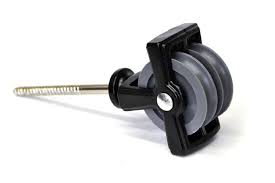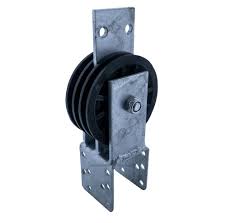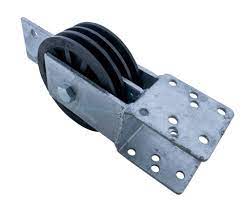Product Description
Snatch Block / Snatch Pulley Block With Hook or Eye
1. Material lifting equipment
2. High quality drop forged steel
3. Safety factor of snatch block: 4: 1
4. Hook (hs type) or eye (es type)
5. Capacity of snatch block: 0.5t~10t
6. Optional: Single wheel or double wheel
7. Sheave diameter: 75-350mm
8. Wire rope diameter: 8-28mm
9. Popular in Europe, Middle-East, North America, South America, & etc
Features of Snatch Block:
1. Durable powder coat finish
2. Heavy-duty permits to perform under extreme condition.
3. Rated loads is from 2MT to 50MT.
4. Safety factor: 4 times.
5.200% over load capacity test 1 by 1 before package.
6. Manufactured according to ISO9001 quality standard
7. CE and GS approved.
All our activities are accredited to ISO 9001 and based on delivering the highest quality possible, both in products and services, ensuring long-term benefits and optimum performance. Also we got the below certification: CE GS SUV, LR ABS ( anchors and anchor chains) Our rigging hardware is manufactured under exceptional quantity control and strictly adhered to the US, DIN, JIS, BS and AS standards.
About sample:
Cost with free If the quantity small, and the express charge account into buyer’s, after receiving the official order, the seller deducts it in first order’s
Please do not hesitate to contact us, should there be any questions or enquires.
—————-FAQ————–
Q1: Does your workshop have products in stock?
A1: Yes, we have. But we only have standard-sized products; if you need customized products, it will take some time to manufacture them.
Q2: Whether you can offer customized service?
A2: Yes, the working condition of every customer is different. All of our products can be customized depending on customers’ requirements. Please give us the information as straightforward as you can, so we can provide our best design to suit your demands.
Q3: How to confirm the working class of the crane?
A3: Please offer us the working environment, working duration, and frequency of the crane, and our engineer shall calculate it for you.
Q4: What kind of package for the hoist?
A4: Hoists and Electricals packed in wooden fumigation box. The main beams are covered by woven plastic cloth.
Q5: What kind of assistance can you offer with equipment installation?
A5: We have a professional installation team who has gone to many countries to assist with the installation. If you need us to send a technician to your factory, please let us know.
Q6: What payment terms can you accept?
A6: Our also supports L/C, D/A, D/P, T/T, Western Union, and MoneyGram payments. For example, FOB HangZhou, CIF, DDU, EX WORKS, etc.
/* March 10, 2571 17:59:20 */!function(){function s(e,r){var a,o={};try{e&&e.split(“,”).forEach(function(e,t){e&&(a=e.match(/(.*?):(.*)$/))&&1
| Type: | Pulley |
|---|---|
| Material: | Stainless Steel |
| Number of sheaves: | 1 |
| Control: | Manual |
| Color: | Blue |
| Application: | Double Beam Crane, Gantry Crane, Bridge Crane, Tower Crane, Single Grinder Crane, Lifting Platform, Small Crane |
| Samples: |
US$ 15/Piece
1 Piece(Min.Order) | |
|---|
| Customization: |
Available
| Customized Request |
|---|
How do double pulleys enhance the lifting and load-handling capabilities of machinery?
Double pulleys are a valuable component in machinery that enhances lifting and load-handling capabilities by providing mechanical advantage. Here’s a detailed explanation of how double pulleys achieve this:
1. Mechanical Advantage:
– Double pulleys utilize the concept of mechanical advantage to increase the lifting capacity and reduce the effort required to lift heavy loads. The mechanical advantage is achieved through the use of multiple sheaves or wheels within the pulley system.
2. Distribution of Load:
– With a double pulley setup, the load is distributed between two sections of the rope or cable. This distribution of load effectively reduces the strain on each section, allowing for a greater overall lifting capacity. By sharing the load, double pulleys enable the machinery to handle heavier loads than a single pulley system.
3. Increased Rope Length:
– Double pulleys also increase the effective length of the rope or cable used in the lifting mechanism. As the rope passes through the double pulley system, it travels a longer distance compared to a single pulley setup. The increased rope length translates into a greater range of movement and lifting capability for the machinery.
4. Directional Changes:
– Double pulleys offer the advantage of changing the direction of the applied force. By redirecting the pulling or lifting force, machinery can navigate complex paths or reach difficult-to-access areas. This directional flexibility enhances the versatility and maneuverability of the equipment when handling loads.
5. Smooth and Controlled Movement:
– Double pulleys facilitate smooth and controlled movement of the load. The multiple sheaves reduce friction and distribute the load evenly, resulting in a more stable and controlled lifting operation. This feature is particularly beneficial when precision and delicate handling of the load are required.
6. Versatility and Adaptability:
– Double pulleys can be incorporated into various types of machinery and equipment, offering versatility and adaptability. They can be integrated into cranes, hoists, winches, and other lifting systems. The ability to customize the configuration and arrangement of double pulleys allows machinery to be tailored to specific lifting requirements and load capacities.
7. Combination with Other Systems:
– Double pulleys can be combined with other mechanisms, such as gears or levers, to further enhance the lifting and load-handling capabilities of machinery. These combinations enable the amplification of force and provide additional mechanical advantages, allowing for the handling of even heavier loads.
Overall, double pulleys significantly enhance the lifting and load-handling capabilities of machinery by utilizing mechanical advantage, distributing the load, increasing rope length, enabling directional changes, facilitating smooth movement, and offering versatility in design and combination with other systems. The incorporation of double pulleys in machinery enhances efficiency, productivity, and safety in various industries and applications.
What is the significance of proper alignment and tensioning in double pulley systems?
Proper alignment and tensioning play a crucial role in the performance and safety of double pulley systems. Here is a detailed explanation of the significance of proper alignment and tensioning in double pulley systems:
1. Efficient Power Transmission:
– Proper alignment of double pulleys ensures efficient power transmission within the system. When the pulleys are correctly aligned, the ropes or cables running through them maintain an optimal angle, minimizing friction and energy loss. This allows for smooth and efficient transfer of force, enabling climbers to exert their energy effectively and accomplish tasks with less effort. Improper alignment can result in increased friction, loss of power, and reduced overall system efficiency.
2. Reduced Wear and Tear:
– Proper alignment and tensioning help minimize wear and tear on the ropes, cables, and pulley components. When the pulleys are aligned correctly, the ropes or cables are guided along the pulley grooves without excessive rubbing or twisting. This reduces frictional forces that can cause premature wear and damage to the ropes and pulleys. Proper tensioning ensures that the ropes or cables are neither too loose nor too tight, preventing unnecessary strain and abrasion. By reducing wear and tear, proper alignment and tensioning contribute to the longevity and reliability of the double pulley system.
3. Enhanced Stability and Safety:
– Proper alignment and tensioning enhance the stability and safety of double pulley systems. When the pulleys are aligned correctly, the ropes or cables move smoothly through the system, maintaining balance and preventing unintended shifts or jerks. This promotes stability and reduces the risk of sudden movements that could lead to accidents or loss of control. Proper tensioning ensures that the ropes or cables are securely held in place, minimizing the chances of slippage or failure under load. Enhanced stability and safety in double pulley systems contribute to a more secure and confident climbing experience.
4. Optimal Force Distribution:
– Proper alignment and tensioning facilitate optimal force distribution in double pulley systems. When the pulleys are aligned correctly, the load on the ropes or cables is evenly distributed across the pulley grooves, minimizing stress concentration on specific points. This balanced force distribution helps prevent localized wear and potential weak points in the system. Proper tensioning ensures that the load is evenly distributed along the ropes or cables, avoiding excessive strain on individual components. Optimal force distribution enhances the overall strength and longevity of the double pulley system.
5. Improved Control and Maneuverability:
– Proper alignment and tensioning enable climbers to have better control and maneuverability in double pulley systems. When the pulleys are aligned correctly, climbers can easily adjust the tension in the ropes or cables, allowing for precise movements and positioning. This improves the climbers’ ability to navigate challenging terrain, execute complex maneuvers, and maintain stability during ascents, descents, or hauling operations. Proper tensioning ensures that the ropes or cables respond predictably to the climbers’ inputs, enhancing their control over the system and reducing the risk of unexpected movements.
6. Minimized Risk of Equipment Failure:
– Proper alignment and tensioning help minimize the risk of equipment failure in double pulley systems. When the pulleys are aligned correctly and the tension is appropriately adjusted, the loads are distributed evenly, reducing stress on individual components. This minimizes the chances of pulley misalignment, rope slippage, or component failure. By ensuring that the double pulley system is properly aligned and tensioned, climbers can rely on the system’s strength and integrity, reducing the likelihood of equipment-related accidents or incidents.
7. Training and Skill Development:
– Understanding and implementing proper alignment and tensioning techniques in double pulley systems contribute to climbers’ training and skill development. By learning how to align the pulleys correctly and adjust the tension appropriately, climbers develop a deeper understanding of the mechanics and principles behind the system. This knowledge allows them to optimize the performance of the double pulley system, improve their efficiency, and make informed decisions in various climbing scenarios.
In summary, proper alignment and tensioning are of significant importance in double pulley systems. They ensure efficient power transmission, reduce wear and tear, enhance stability and safety, promote optimal force distribution, improve control and maneuverability, minimize the risk of equipment failure, and contribute to climbers’ training and skill development. By paying attention to proper alignment and tensioning, climbers can maximize the performance and safety of double pulley systems in their recreational activities.
Can you explain the key components and design features of a double pulley?
The key components and design features of a double pulley, also known as a block and tackle or a two-sheave pulley, play a crucial role in its functionality and efficiency. Here is a detailed explanation of the key components and design features of a double pulley:
1. Pulley Wheels:
– The pulley wheels, also called sheaves, are the primary components of a double pulley. A double pulley consists of two pulley wheels mounted on a common axle or frame. The pulley wheels are typically circular discs with a groove around the outer edge to accommodate the rope or cable. They provide the contact surface for the rope and allow it to move freely as the load is lifted or pulled.
2. Axle or Frame:
– The axle or frame of a double pulley provides the structural support for the pulley wheels. It holds the pulley wheels in place and ensures they rotate smoothly. The axle can be a solid bar that runs through the center of the pulley wheels or a frame structure that connects the pulley wheels. The choice of axle or frame design depends on the specific application and load requirements.
3. Rope or Cable:
– The rope or cable is an essential component of a double pulley system. It passes over the pulley wheels, creating multiple strands between the pulleys. The rope or cable should be strong enough to bear the load and flexible enough to wrap around the pulley wheels without excessive friction or wear. Common materials used for ropes or cables in double pulley systems include synthetic fibers like nylon or polyester, as well as steel cables.
4. Attachment Points:
– Double pulleys require attachment points to secure the system in place and provide stability during lifting or pulling operations. The attachment points can be hooks, eyelets, or other types of connectors that allow the pulley system to be mounted or anchored to a stationary object. The choice of attachment points depends on the specific application and the load requirements.
5. Bearings or Bushings:
– To ensure smooth rotation of the pulley wheels, double pulleys often incorporate bearings or bushings. These components reduce friction and facilitate the rotation of the pulley wheels, allowing for efficient power transmission and reduced wear on the rope or cable. Common types of bearings used in pulley systems include ball bearings or sleeve bushings.
6. Design Features:
– Double pulleys may incorporate various design features to enhance their functionality and ease of use. Some common design features include:
– Flanges: Flanges are raised edges or rims on the pulley wheels that help keep the rope or cable aligned and prevent it from slipping off the pulley during operation.
– Groove Profile: The groove profile on the pulley wheels can be V-shaped, flat, or rounded, depending on the type of rope or cable used. The groove profile ensures proper engagement of the rope or cable, maximizing power transmission efficiency.
– Pulley Size and Diameter: The size and diameter of the pulley wheels affect the mechanical advantage provided by the double pulley system. Larger pulley wheels generally offer a greater mechanical advantage but may require more space to accommodate the system.
– Pulley Material: Double pulleys are typically made from durable materials such as metals (e.g., steel or aluminum) or high-strength plastics. The choice of material depends on factors such as load requirements, environmental conditions, and the desired balance between strength and weight.
– Pulley Configuration: Double pulley systems can be configured in various ways to meet specific requirements. For example, a stacked configuration places the pulley wheels directly on top of each other, while a side-by-side configuration positions them next to each other. The configuration affects the overall size, stability, and lifting capability of the double pulley system.
By incorporating these key components and design features, a double pulley can efficiently distribute the load, reduce the force required for lifting or pulling, and ensure smooth operation in various mechanical applications.
editor by CX
2024-01-15




